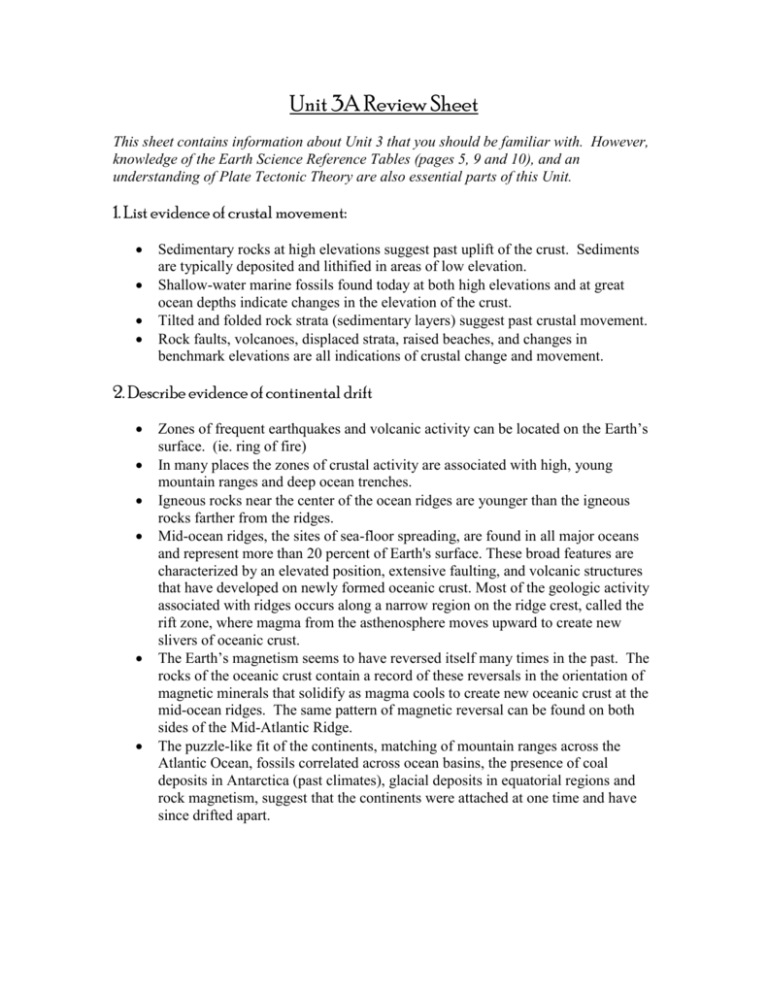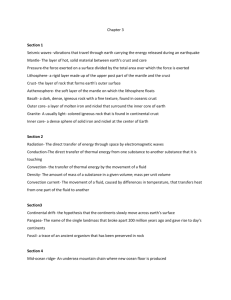Unit 3A Review Sheet
advertisement

Unit 3A Review Sheet This sheet contains information about Unit 3 that you should be familiar with. However, knowledge of the Earth Science Reference Tables (pages 5, 9 and 10), and an understanding of Plate Tectonic Theory are also essential parts of this Unit. 1. List evidence of crustal movement: Sedimentary rocks at high elevations suggest past uplift of the crust. Sediments are typically deposited and lithified in areas of low elevation. Shallow-water marine fossils found today at both high elevations and at great ocean depths indicate changes in the elevation of the crust. Tilted and folded rock strata (sedimentary layers) suggest past crustal movement. Rock faults, volcanoes, displaced strata, raised beaches, and changes in benchmark elevations are all indications of crustal change and movement. 2. Describe evidence of continental drift Zones of frequent earthquakes and volcanic activity can be located on the Earth’s surface. (ie. ring of fire) In many places the zones of crustal activity are associated with high, young mountain ranges and deep ocean trenches. Igneous rocks near the center of the ocean ridges are younger than the igneous rocks farther from the ridges. Mid-ocean ridges, the sites of sea-floor spreading, are found in all major oceans and represent more than 20 percent of Earth's surface. These broad features are characterized by an elevated position, extensive faulting, and volcanic structures that have developed on newly formed oceanic crust. Most of the geologic activity associated with ridges occurs along a narrow region on the ridge crest, called the rift zone, where magma from the asthenosphere moves upward to create new slivers of oceanic crust. The Earth’s magnetism seems to have reversed itself many times in the past. The rocks of the oceanic crust contain a record of these reversals in the orientation of magnetic minerals that solidify as magma cools to create new oceanic crust at the mid-ocean ridges. The same pattern of magnetic reversal can be found on both sides of the Mid-Atlantic Ridge. The puzzle-like fit of the continents, matching of mountain ranges across the Atlantic Ocean, fossils correlated across ocean basins, the presence of coal deposits in Antarctica (past climates), glacial deposits in equatorial regions and rock magnetism, suggest that the continents were attached at one time and have since drifted apart. 3. Interpret inferred properties of Earth’s interior using p. 10 of your ESRT Seismic (earthquake) waves allow scientists to make inferences about Earth’s interior. The speed of a seismic waves varies with the physical properties of the material through which the wave is traveling. (Waves travel faster through denser rock). Analysis of seismic data leads to the inference that solid zones (crust, mantle, and inner core) and a liquid zone (outer core) exist within the Earth. The Mohorovicic discontinuity, or Moho, is the boundary between the crust and the mantle. The average thickness of the continental crust is greater than the average thickness of the oceanic crust. The oceanic and continental crusts have different compositions. (Oceanic= mafic, basaltic, and high density; Continental=felsic, granitic, and low density) The density, temperature, and pressure of the Earth’s interior increase with depth. 4. Explain Plate Tectonic Theory The theory of plate tectonics states that the solid lithosphere (crust and rigid mantle) consists of a series of plates that “float” on the partially molten Asthenosphere (plastic mantle). Convection currents within the asthenosphere are thought to move the plates. Convection is the distribution of energy that makes your lava lamp work. Some regions become hotter and less dense than their surroundings and begin to rise, while cooler, denser material sinks. 5. Describe the types of plate boundaries and the geological features found at each type. Transform plate boundary- A boundary between two lithospheric plates where the plates are sliding horizontally past one another. A good example is the San Andreas Fault in California Divergent plate boundary- A boundary where two lithospheric plates move away from each other, and new oceanic crust is formed. Convergent plate boundary- A boundary where two lithospheric plates are coming together: o Oceanic-Continental plate Boundary (Ex/ Peru-Chile Trench) o Oceanic-Oceanic Plate Boundary (Ex/ Aleutian Trench) o Continental- Continental plate Boundary (Ex/ Himalayan Mountains) Subduction zones exist at convergent plate boundaries when one plate is forced down beneath another plate. This process creates trenches, island arcs, and volcanic mountain ranges. 6. Describe Hot spots A geologic 'hot spot' is an area of unusually high heat flow in the mantle where magma is rising. Hot spots are stationary as the plates move above them. Magma breaks through and produces undersea volcanoes. Some of these volcanoes build up to the surface of the ocean and become islands. Over millions of years the plate may move across the 'hot spot.' The original volcano becomes extinct, but a new volcano will begin to form in the area of the 'hot spot.' A hot spot can also exist under the continental crust (Yellowstone National Park in northwestern Wyoming). Hawaii’s Hot Spot: o The Hawaiian Islands get older to the northwest, indicating that the Pacific Plate is moving to the northwest. The Hawaiian Ridge-Emperor Seamounts chain extends some 6,000 km from the "Big Island" of Hawaii to the Aleutian Trench off Alaska. A sharp bend in the chain indicates that the motion of the Pacific Plate abruptly changed about 43 million years ago, as it took a more westerly turn from its earlier northerly direction. On the seafloor to the southeast of Hawaii is an active volcanic area with periodic eruptions. This area is called Loihi and will be the site of the next Hawaiian Island more than 10,000 years from now.









